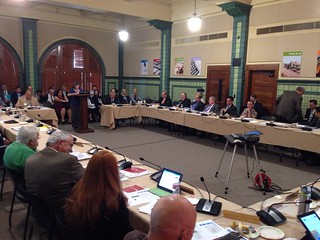 In early November 2013, the San Bernardino Association of Governments (SANBAG) board adopted a historic Memorandum of Understanding (MOU) (Item 7) with the Southern California Association of Governments (SCAG). The MOU commits the two agencies to working together on projects related to the implementation of the 2012 Regional Transportation Plan and Sustainable Communities Strategy (RTP/SCS). While the RTP/SCS is mandated by SB 375, state legislation to reduce greenhouse gas emissions through trying land use and transportation planning in the RTP process, the MOU is strictly voluntary.
In early November 2013, the San Bernardino Association of Governments (SANBAG) board adopted a historic Memorandum of Understanding (MOU) (Item 7) with the Southern California Association of Governments (SCAG). The MOU commits the two agencies to working together on projects related to the implementation of the 2012 Regional Transportation Plan and Sustainable Communities Strategy (RTP/SCS). While the RTP/SCS is mandated by SB 375, state legislation to reduce greenhouse gas emissions through trying land use and transportation planning in the RTP process, the MOU is strictly voluntary.
The MOU between SCAG and SANBAG demonstrates both agencies’ commitment to the policies, projects and strategies set forth in the 2012 RTP/SCS. It is important for County Transportation Commissions (CTCs) to show commitment to implementation of plans and policies.
Specific planning projects are included in SANBAG’s MOU that will transform San Bernardino County into a more walkable and bikeable place, improve the public health outcomes of its residents and help increase the number of children walking and bicycling to school. The MOU incorporates items recommended in the San Bernardino Active Transportation Vision, statistics and policy recommendations developed by stakeholders from San Bernardino County, including SANBAG staff, San Bernardino County Department of Public Health, Omnitrans, Safe Routes Partnership, American Lung Association, MoveIE and Inland Empire Bicycle Alliance.SANBAG’s MOU will directly affect the way children and students travel to school. The two policies that include strategies for schools are:
- Development of a “Safe Routes to School Inventory”
- Implementation of first-last mile strategies from the award winning “Improvement to Transit Access for Cyclists and Pedestrians” plan.
The first strategy, increasing data collection on Safe Routes to School programs, will help the county and local cities gain a big picture perspective on land use and transportation policy impacts. This data will provide policy makers and agency staff with information to prioritize the needs of cities, such as safety, environment, community development and public health, and link Safe Routes to School funding with countywide bicycle and pedestrian networks. The Safe Routes to School inventory may even lead to more expansive policy efforts, including citywide and countywide Safe Routes to School strategic plans.
The second strategy, implementation of the Transit Access for Cyclists and Pedestrians Plan, will increase access to schools and educational institutions and increase possibilities for combining walking and bicycling with public transportation in San Bernardino County.
Other recommendations in the MOU related to active transportation also encourages SANBAG and San Bernardino County decision-makers to build walkable and bikeable communities, including:
- Explore opportunities to “Expedite Active Transportation Funding” to improve bicycle and pedestrian connectivity countywide.
- Develop “Performance Measurements and Monitoring” for health, greenhouse gas reductions, etc.
- Support the development of “Complete Street Policies” throughout the county and include these components in upcoming countywide projects.
- Support “Legislative Initiatives” that would increase funding for multimodal planning.
The adoption of active transportation policies in the MOU provides opportunities for educating the public, leaders and elected officials about active transportation and its benefits. For children and families in the county, implementation of existing and future bicycle and pedestrian plans will change how they travel to school, work and play. Also, many community colleges, colleges and universities are within the bicycle and pedestrian catchment area, which will influence transportation choices and behaviors of new generations.
At this time, Los Angeles County is the only other county in the Southern California with an MOU with SCAG. As part of our efforts with the regional network project, we will be advocating for other counties to adopt similar MOUs with SCAG and monitor the implementation of existing MOUs.
Further reading:
- Read about the impacts of programs and policies of the 2012 RTP/SCS on active transportation in Reflections of Active Transportation in the 2012 SCAG RTP/SCS
- Read about how SANBAG fits into the transportation decision-making in Southern California in Should SANBAG Expand its role as a COG

